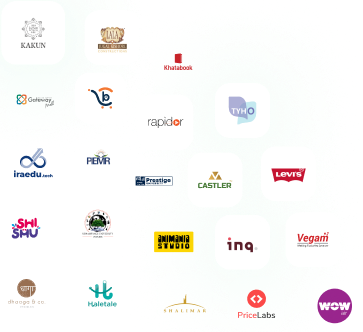Table Of Content
- What is Hyper-Personalization in WordPress E-Commerce?
- The Evolution of Personalization in E-Commerce Design
- Why Hyper-Personalization is Essential for E-Commerce Success
- Core Features of Hyper-Personalized Product Pages
- How Data-Driven Insights Enable Hyper-Personalization
- Top Tools for Creating Personalized Product Pages in WordPress
- Customizing Product Pages to Reflect Brand Identity
- Hyper-Personalized Pages vs. Standard Product Pages
- Enhancing Accessibility in Hyper-Personalized E-Commerce Design
- Challenges of Implementing Hyper-Personalization in WordPress
- Real-World Examples of Hyper-Personalized Product Pages
- Expert Tips for Designing Hyper-Personalized Product Pages
- Future Trends in Hyper-Personalized E-Commerce Experiences
- How Hyper-Personalization Impacts User Experience and Business ROI
- FAQs
When it comes to the current competitive landscape of e-commerce, a customer these days expects a highly tailored and seamless experience. Hyper-personalized product pages in WordPress e- commerce are designed to meet this demand by rendering content, offers, and recommendations to resonate with each unique visitor. By merging advanced technologies such as AI-powered personalization and data-driven insights for e-commerce, WordPress sites can create dynamic, user-focused product pages that will enhance engagement but at the same time maximize business ROI.This guide focuses on the strategies, tools, and challenges of hyper-personalized product pages using WordPress, along with future trends and directions.
What is Hyper-Personalization in WordPress E-Commerce?
Hyper-personalization differs from traditional personalization methods because it applies real-time data and AI algorithms coupled with advanced analytics to create product pages that cater to individual users. When contrasted with basic personalization, which may result in static recommendations based on purchase history, it dynamically adjusts to user behavior, preferences, and context.In e-commerce by WordPress, it depends on the modular nature and vast plugin library of the platform to accommodate individualization in the shape of hyper-personalization, so that every interaction feels personal and relevant to the customer-from real-time product suggestions to localized content.Key Components of Hyper-Personalization:
- Behavioral Insights: Analyzing how users interact with the website to determine preferences.
- Real-Time Adaptation: The change in product recommendations and content in real-time.
- Dynamic Content Delivery: Customizing page elements like banners, calls-to-action, and pricing.
- Predictive Analytics: Making predictions on customers' requirements through historical and contextual data.
The Evolution of Personalization in E-Commerce Design
Personalization in e-commerce has evolved from basic algorithms to sophisticated, AI-driven processes. Here's how that progression happened:- Static Recommendations A generic type of product recommendation, such as "Customers also bought", appeared on earlier versions of e-commerce sites based on very limited data, typically giving users useless recommendations.
- Rule-Based Personalization When segmentation was introduced, sites could dynamically serve content to particular user groups, like discount offers to first-time visitors or seasonal offers.
- Real-Time Dynamic Content New AI and machine learning capabilities imbued adaptability in real-time to e-commerce ventures. Websites started displaying the items viewed recently or time-bound offers in real-time as a response to user actions.
- AI-Empowered Hyper-Personalization The latest version of e-commerce platforms, modern and contemporary that utilize AI, now supports personalization technologies that enable predictive analytics, automated segmentation, and behavior-based targeting. These technologies drive experiences that feel freshly baked for each shopper.
Why Hyper-Personalization is Essential for E-Commerce Success
Success in e-commerce is fueled by hyper-personalization: it guarantees to the customer a seamless, relevant experience.Benefits for E-commerce Businesses:- Higher conversion: Personalized recommendations have a greater chance of purchase
- Improved user retention: Hyper-personalized experiences allow stronger connections and encourage coming back
- Low cart abandonment: Tailored incentives like customized discounts call users to complete the buy
- Increased Average Order Value (AOV): Upselling and cross-selling become much more effective with data-driven recommendations.
- Enhanced Customer Loyalty: Hyper-personalization creates a sense of value, fostering brand loyalty.
Core Features of Hyper-Personalized Product Pages
To develop hyper-personalized product pages, it is necessary to include several advanced features catering to individual users:Real-time RecommendationsThe recommendations are updated based on the browsing pattern by the user, reflecting his/her preferences and past interactions.- Localized ContentPages adjust automatically according to the user's region, currency, language, and offers.
- Dynamic LayoutsElements such as banners, pop-ups, and CTAs make the experience intuitive and engaging by adapting to user behavior.
- Behavior-based promotionsDiscounts or offers are set off by certain actions, for instance, adding products to the cart or abandoning a purchase.
- AI-Powered SearchSmart search devices predict the search terms and present the most relevant results promptly.
How Data-Driven Insights Enable Hyper-Personalization
Data is the core of hyper-personalization. Sophisticated analytics tools collect and decode user data to aid informed decision-making.Major Source of Data- The behavior of Users: Clickstream, browse the history, and time spent on pages
- Purchase History: Transactions made in the past reveal preferences
- Demographics: Age, gender, and location allow for tailored content from the onset
- Real-Time Feedback: Heatmaps, session replays, and user surveys identify where to improve
- Anticipates the needs of users, which ensures satisfaction
- Improve user flow and consequently reduce the bounce rate.
- Boosts marketing ROI through targeted campaigns.
Top Tools for Creating Personalized Product Pages in WordPress
WordPress has multiple plugins and tools to execute hyper-personalization:- WooCommerce Dynamic Pricing & DiscountsPersonalize your pricing policies with relevant reductions.
- OptinMonsterDesign behavior-activated pop-ups and targeted forms for capturing leads.
- Personalize.jsServe dynamic content directly on the product page with JavaScript.
- Evergage (Salesforce Interaction Studio)Harness real-time behavioral analytics to design personalized experiences.
- Elementor ProCustomize layouts and elements of WordPress's product page with advanced design tools
- Google OptimizeA/B testing to enhance and refine personalized experiences.
Customizing Product Pages to Reflect Brand Identity
The personal pages should reflect your brand's basic identity. Key tactics are:- Visual Consistency Apply your brand's fonts, colors, and imagery consistently.
- Content Tone: Use a consistent voice that speaks to your audience.
- Unique Layouts: Personalization should enhance, not overshadow, your brand's aesthetic.
Hyper-Personalized Pages vs. Standard Product Pages
Content:- Standard Pages: Content that is static and does not change for any user, irrespective of their preference or behavior.
- Hyper-Personalized Pages: Display dynamic, user-specific content according to individual preferences, like personalized recommendations or targeted offers.
- Standard Pages: It's relatively average, as content might not stimulate every user
- Hyper-Personalized Pages: It is high as it will display some product offerings, deals, or layouts relevant to user behavior and preferences.
- Standard Pages: Average Conversion Rates Since the content is general and not targeted toward any person, it likely has a lower conversion rate.
- Hyper-Personalized Pages: Great Conversion Rates because it can provide experiences tailor-made according to individual user needs.
- Standard Pages: Basic Accessibility Features Catering to General Audiences
- Hyper-Personalized Pages: Enhancing Accessibility with dynamic updates of content to make all the content accessible to every user group
- Standard Pages: Average ROI since it doesn't use user-specific strategies.
- Hyper-Personalized Pages: Maximize ROI by delivering experiences that increase purchase likelihood and customer satisfaction.
- Standard Pages: Have fixed layouts that do not adjust based on user behavior or preferences
- Hyper-Personalized Pages: Dynamically adjust the layouts; that is, focus on the products or features that appeal to individual users
- Standard Pages: Do not create repeat visits as they are not relevant.
- Hyper-Personalized Pages: Increases the loyalty of customers since it offers constantly tailored experiences that meet the expectations of a user.
Enhancing Accessibility in Hyper-Personalized E-Commerce Design
Accessible design ensures inclusivity, enabling all users to benefit from personalization:- Keyboard navigation: Make all interactive elements accessible by the keyboard.
- Screen reader support: Provide alternative text for dynamic images and labels for any interactive element.
- Colour Contrast Provide enough contrast ratios to aid the visually impaired.
- Responsive Design: Ensure pages adapt seamlessly across devices and screen sizes.
Challenges of Implementing Hyper-Personalization in WordPress
Implementing hyper-personalization is very challenging- Data Privacy: Balancing GDPR compliance with data collection.
- Technical Complexity: Multiple tools and platforms have to be integrated.
- Cost: Advanced plugins and tools are very costly for small businesses.
- Performance: Dynamic content may impact page load speeds, therefore impacting SEO.
Real-World Examples of Hyper-Personalized Product Pages
Amazon Utilizes AI for personalized product offers, specific promotions, and dynamic pricing.Nike Uses consumer preference to personalize product recommendations and fitness programs.Shopify Stores The more popular Shopify stores use applications like Nosto, where product pages and marketing campaigns are hyper-personalized.Expert Tips for Designing Hyper-Personalized Product Pages
- Use AI Tools: Utilize AI for predictive analytics and behavior-driven recommendations.
- A/B Testing: Continuously test various elements to enhance the user experience.
- Optimize Page Speed: Make sure dynamic content doesn't drain the site.
- Accessibility as Focus: Make Personalized Experiences Accessible for All.
Future Trends in Hyper-Personalized E-Commerce Experiences
The future of hyper-personalization lies in cutting-edge technologies:- Voice commerce: True-to-life shopping experience by voice assistants.
- AR Integration: Let users see and experience products in the real world.
- Predictive algorithms-Predict user needs with ever higher accuracy.
- Blockchain Security: Protect user data while enabling advanced personalization.
How Hyper-Personalization Impacts User Experience and Business ROI
Hyper-personalized pages transform the user experience by:- Simplifying Navigation: Users find what they need faster.
- Building Trust: Shoppers feel valued and understood.
- Improving Satisfaction: Personalized content resonates more deeply.
- Increasing Sales: More relevant recommendations lead to higher conversions.
- Reducing Marketing Costs: Efficient targeting minimizes wasted spend.
- Enhancing Retention: Loyal customers drive repeat business and referrals.
FAQs
1. Can I implement hyper-personalization on WordPress?
Yes, it provides plenty of plugins and tools like WooCommerce, OptinMonster, and Dynamic Pricing and Discounts, which successfully support a personalized product page.2. How does insight driven by data enhance hyper-personalization?
Data-driven insight analyzes user behavior, demographics, and preferences, making it easier for the business to predict needs and display relevant products, hence increasing engagement and sales.3. Which are the top WordPress plugins for personalization?
Some of the top WordPress plugins for personalization are:- WooCommerce – Best for e-commerce functionality.
- OptinMonster – Personalized pop-ups and product recommendations.
- Elementor – Custom designs for product pages.
- Dynamic Pricing and Discounts – Tailored pricing strategies for your customers.
4. How does AI contribute to hyper-personalized product pages?
AI tools process real-time user data, predicting preferences and updating content, layouts, and recommendations for a seamless shopping experience.5. Are hyper-personalized pages accessible to all users?
Yes, hyper-personalized pages can be designed with accessibility features, such as adaptive content for screen readers and customizable layouts, ensuring inclusivity for diverse user groups.The world’s First zero commission platform
Hire tech partners effortlessly
 If you're a non-tech founder looking for an agency or a tech founder looking for engineers.
If you're a non-tech founder looking for an agency or a tech founder looking for engineers. You can get your 5 best matches from 2800 in 5 mins, with 1000 data points tracked.
You can get your 5 best matches from 2800 in 5 mins, with 1000 data points tracked. Connect directly with no credit card needed!
Connect directly with no credit card needed!
You’re just a click away from the best talent.


